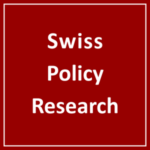Covid19: Italian Antibody Data
COVID19 - CORONAVIRUS, 10 Aug 2020
Swiss Policy Research - TRANSCEND Media Service
5 Aug 2020 – The Italian health and statistics authorities ISS and ISTAT have published the results of their first nationwide coronavirus antibody study based on close to 65,000 participants.
The study found a nationwide IgG antibody prevalence of 2.5%. The highest prevalence was found in the northern region of Lombardy (7.5%), the lowest prevalence was found in the southern region of Sicily (0.3%). (See chart below).
In the former coronavirus hotspot provinces of Bergamo and Cremona (both within Lombardy region), IgG antibody prevalence was 24% and 19%, matching other global hotspots like New York and once again confirming a ~20% IgG antibody prevalence threshold.
(Earlier reports that Bergamo allegedly had 57% antibody prevalence were likely based on hospitalized patients or severe cases and were not representative for the whole population.)
27% of people with antibodies remained asymptomatic, 23% had 1-2 (mild) symptoms, and 41% had 3 or more symptoms or a temporary loss of the sense of smell or taste.
Importantly, only 25% to 27% of people who reported a temporary loss of the sense of smell or taste – a very typical Covid-19 symptom – had IgG antibodies.
This confirms the results of the previous Spanish antibody study and once again shows that only a fraction of the people who likely had contact with the new coronavirus (need to) develop IgG antibodies to neutralize the virus. Instead, many people neutralize the virus with pre-existing or new T-cells or with mucosal (IgA) antibodies, as first shown by a Swiss immunological study.
In turn, this means that even in former hotspots like Bergamo – which pioneered the fatal strategy of moving Covid patients into nursing homes, a mistake later copied by places like New York and New Jersey – the population-adjusted Covid lethality (IFR) is likely close to 0.1%, as 80% or more of the population may already have come into contact with the new coronavirus.
However, Bergamo was caught off guard by the very rapid pre-symptomatic spread of the virus and subsequently suffered a collapse of its elderly care and health care system and an extremely high mortality during several weeks in March, leading to the notorious television images.
While places like Bergamo and Cremona likely reached the much-cited “herd immunity” threshold, most other regions of Italy are still far from such levels and thus remain vulnerable to the new coronavirus. The same is true for places like Germany with only 1.3% IgG prevalence.
Instead of permanently or repeatedly locking down their societies while waiting for an uncertain vaccine, these and many other places should urgently consider an early treatment strategy for the high-risk segment of their population and study the Swedish approach to pandemic management.
Interestingly, it was an Italian group that first proposed (based on German virological research) to repurpose the simple over-the-counter mucolytic cough medication bromhexine to block TMPRSS2/ACE2-dependent cell entry of the new coronavirus – recently found to be successful.
Moreover, Italian doctors were among the first in Europe (after successes in China and South Korea) to apply the malaria drug HCQ in an outpatient setting (at home) during lockdown, a strategy that dramatically reduced hospitalization and death rates among their patients.
More: Results of the Italian antibody seroprevalence study (ISTAT, August 3, 2020)

See also:
__________________________________________
 Swiss Policy Research, founded in 2016, is an independent, nonpartisan and nonprofit research group investigating geopolitical propaganda in Swiss and international media. SPR is composed of independent academics that for personal and professional reasons prefer to protect their identities, and receives no external funding; there are no financial sponsors or backers. Our articles have been published or shared by numerous independent media outlets and journalists, among them Julian Assange, and have been translated into more than two dozen languages.
Swiss Policy Research, founded in 2016, is an independent, nonpartisan and nonprofit research group investigating geopolitical propaganda in Swiss and international media. SPR is composed of independent academics that for personal and professional reasons prefer to protect their identities, and receives no external funding; there are no financial sponsors or backers. Our articles have been published or shared by numerous independent media outlets and journalists, among them Julian Assange, and have been translated into more than two dozen languages.
Tags: COVID-19, Coronavirus, Italy
DISCLAIMER: The statements, views and opinions expressed in pieces republished here are solely those of the authors and do not necessarily represent those of TMS. In accordance with title 17 U.S.C. section 107, this material is distributed without profit to those who have expressed a prior interest in receiving the included information for research and educational purposes. TMS has no affiliation whatsoever with the originator of this article nor is TMS endorsed or sponsored by the originator. “GO TO ORIGINAL” links are provided as a convenience to our readers and allow for verification of authenticity. However, as originating pages are often updated by their originating host sites, the versions posted may not match the versions our readers view when clicking the “GO TO ORIGINAL” links. This site contains copyrighted material the use of which has not always been specifically authorized by the copyright owner. We are making such material available in our efforts to advance understanding of environmental, political, human rights, economic, democracy, scientific, and social justice issues, etc. We believe this constitutes a ‘fair use’ of any such copyrighted material as provided for in section 107 of the US Copyright Law. In accordance with Title 17 U.S.C. Section 107, the material on this site is distributed without profit to those who have expressed a prior interest in receiving the included information for research and educational purposes. For more information go to: http://www.law.cornell.edu/uscode/17/107.shtml. If you wish to use copyrighted material from this site for purposes of your own that go beyond ‘fair use’, you must obtain permission from the copyright owner.
Read more
Click here to go to the current weekly digest or pick another article:
COVID19 - CORONAVIRUS: